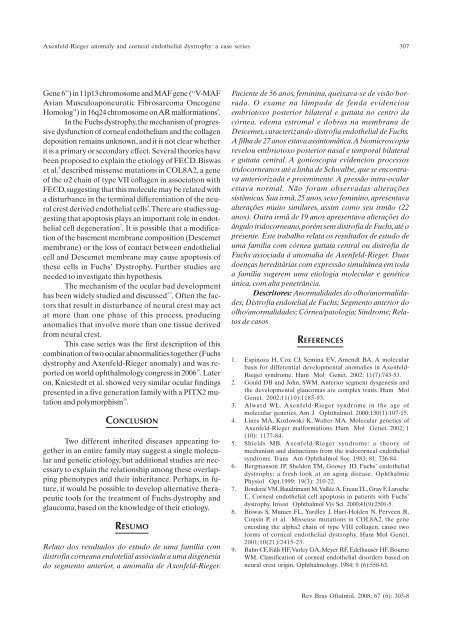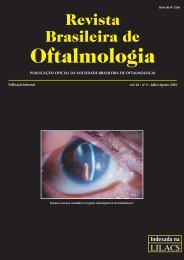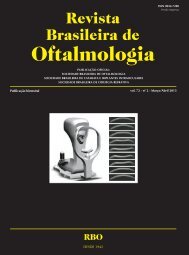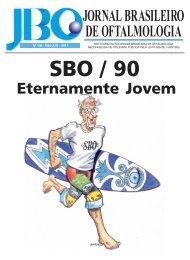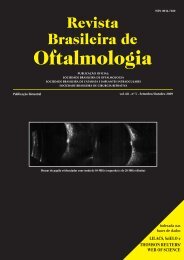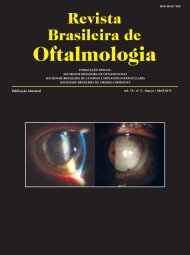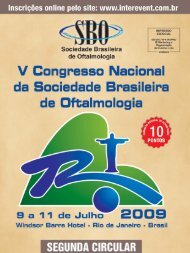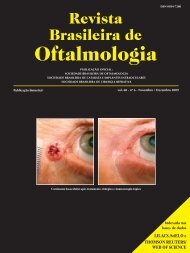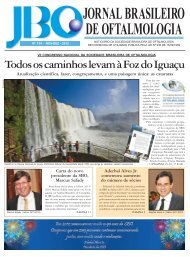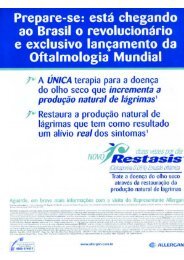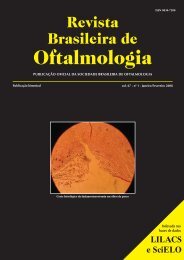Nov-Dez - Sociedade Brasileira de Oftalmologia
Nov-Dez - Sociedade Brasileira de Oftalmologia
Nov-Dez - Sociedade Brasileira de Oftalmologia
You also want an ePaper? Increase the reach of your titles
YUMPU automatically turns print PDFs into web optimized ePapers that Google loves.
Axenfeld-Rieger anomaly and corneal endothelial dystrophy: a case series<br />
307<br />
Gene 6”) in 11p13 chromosome and MAF gene (“V-MAF<br />
Avian Musculoaponeurotic Fibrosarcoma Oncogene<br />
Homolog”) in 16q24 chromosome on AR malformations 4 .<br />
In the Fuchs dystrophy, the mechanism of progressive<br />
dysfunction of corneal endothelium and the collagen<br />
<strong>de</strong>position remains unknown, and it is not clear whether<br />
it is a primary or secondary effect. Several theories have<br />
been proposed to explain the etiology of FECD. Biswas<br />
et al. 8 <strong>de</strong>scribed missense mutations in COL8A2, a gene<br />
of the a2 chain of type VII collagen in association with<br />
FECD, suggesting that this molecule may be related with<br />
a disturbance in the terminal differentiation of the neural<br />
crest <strong>de</strong>rived endothelial cells 8 .There are studies suggesting<br />
that apoptosis plays an important role in endothelial<br />
cell <strong>de</strong>generation 7 . It is possible that a modification<br />
of the basement membrane composition (Descemet<br />
membrane) or the loss of contact between endothelial<br />
cell and Descemet membrane may cause apoptosis of<br />
these cells in Fuchs’ Dystrophy. Further studies are<br />
nee<strong>de</strong>d to investigate this hypothesis.<br />
The mechanism of the ocular bad <strong>de</strong>velopment<br />
has been wi<strong>de</strong>ly studied and discussed 3-5 . Often the factors<br />
that result in disturbance of neural crest may act<br />
at more than one phase of this process, producing<br />
anomalies that involve more than one tissue <strong>de</strong>rived<br />
from neural crest.<br />
This case series was the first <strong>de</strong>scription of this<br />
combination of two ocular abnormalities together (Fuchs<br />
dystrophy and Axenfeld-Rieger anomaly) and was reported<br />
on world ophthalmology congress in 2006 19 . Later<br />
on, Kniestedt et al. showed very similar ocular findings<br />
presented in a five generation family with a PITX2 mutation<br />
and polymorphism 20 .<br />
CONCLUSION<br />
Two different inherited diseases appearing together<br />
in an entire family may suggest a single molecular<br />
and genetic etiology, but additional studies are necessary<br />
to explain the relationship among these overlapping<br />
phenotypes and their inheritance. Perhaps, in future,<br />
it would be possible to <strong>de</strong>velop alternative therapeutic<br />
tools for the treatment of Fuchs dystrophy and<br />
glaucoma, based on the knowledge of their etiology.<br />
RESUMO<br />
Relato dos resultados do estudo <strong>de</strong> uma família com<br />
distrofia corneana endotelial associada a uma disgenesia<br />
do segmento anterior, a anomalia <strong>de</strong> Axenfeld-Rieger.<br />
Paciente <strong>de</strong> 56 anos, feminina, queixava-se <strong>de</strong> visão borrada.<br />
O exame na lâmpada <strong>de</strong> fenda evi<strong>de</strong>nciou<br />
embriotoxo posterior bilateral e guttata no centro da<br />
córnea, e<strong>de</strong>ma estromal e dobras na membrana <strong>de</strong><br />
Descemet, caracterizando distrofia endothelial <strong>de</strong> Fuchs.<br />
A filha <strong>de</strong> 27 anos estava assintomática.A biomicroscopia<br />
revelou embriotoxo posterior nasal e temporal bilateral<br />
e guttata central. A gonioscopia evi<strong>de</strong>nciou processos<br />
iridocorneanos até a linha <strong>de</strong> Schwalbe, que se encontrava<br />
anteriorizada e proeminente. A pressão intra-ocular<br />
estava normal. Não foram observadas alterações<br />
sistêmicas. Sua irmã, 25 anos, sexo feminino, apresentava<br />
alterações muito similares, assim como seu irmão (22<br />
anos). Outra irmã <strong>de</strong> 19 anos apresentava alterações do<br />
ângulo iridocorneano, porém sem distrofia <strong>de</strong> Fuchs, até o<br />
presente. Este trabalho relata os resultados <strong>de</strong> estudo <strong>de</strong><br />
uma família com córnea guttata central ou distrofia <strong>de</strong><br />
Fuchs associada à anomalia <strong>de</strong> Axenfeld-Rieger. Duas<br />
doenças hereditárias com expressão simultânea em toda<br />
a família sugerem uma etiologia molecular e genética<br />
única, com alta penetrância.<br />
Descritores: Anormalida<strong>de</strong>s do olho/anormalida<strong>de</strong>s;<br />
Distrofia endotelial <strong>de</strong> Fuchs; Segmento anterior do<br />
olho/anormalida<strong>de</strong>s; Córnea/patologia; Síndrome; Relatos<br />
<strong>de</strong> casos<br />
REFERENCES<br />
1. Espinoza H, Cox CJ, Semina EV, Amendt BA. A molecular<br />
basis for differential <strong>de</strong>velopmental anomalies in Axenfeld-<br />
Rieger syndrome. Hum Mol Genet. 2002; 11(7):743-53.<br />
2. Gould DB and John, SWM. Anterior segment dysgenesis and<br />
the <strong>de</strong>velopmental glaucomas are complex traits. Hum Mol<br />
Genet. 2002;11(10):1185-93.<br />
3. Alward WL. Axenfeld-Rieger syndrome in the age of<br />
molecular genetics. Am J Ophthalmol. 2000;130(1):107-15.<br />
4. Lines MA, Kozlowski K, Walter MA. Molecular genetics of<br />
Axenfeld-Rieger malformations. Hum Mol Genet. 2002; 1<br />
(10): 1177-84.<br />
5. Shields MB. Axenfeld-Rieger syndrome: a theory of<br />
mechanism and distinctions from the iridocorneal endothelial<br />
syndrome. Trans Am Ophthalmol Soc. 1983; 81: 736-84.<br />
6. Bergmanson JP, Sheldon TM, Goosey JD. Fuchs´ endothelial<br />
dystrophy: a fresh look at an aging disease. Ophthalmic<br />
Physiol Opt.1999; 19(3): 210-22.<br />
7. Bor<strong>de</strong>rie VM, Baudrimont M, Vallée A, Ereau TL, Gray F, Laroche<br />
L. Corneal endothelial cell apoptosis in patients with Fuchs’<br />
dystrophy. Invest Ophthalmol Vis Sci. 2000;41(9):2501-5.<br />
8. Biswas S, Munier FL, Yardley J, Hart-Hol<strong>de</strong>n N, Perveen R,<br />
Cousin P, et al. Missense mutations in COL8A2, the gene<br />
encoding the alpha2 chain of type VIII collagen, cause two<br />
forms of corneal endothelial dystrophy. Hum Mol Genet.<br />
2001;10(21):2415-23.<br />
9. Bahn CF, Falls HF, Varley GA, Meyer RF, E<strong>de</strong>lhauser HF, Bourne<br />
WM. Classification of corneal endothelial disor<strong>de</strong>rs based on<br />
neural crest origin. Ophthalmology. 1984; 9 (6):558-63.<br />
Rev Bras Oftalmol. 2008; 67 (6): 303-8


